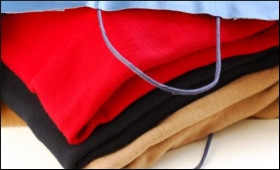|

|
Apparel industry urges govt to check cotton, yarn exports
|
|

|
|
| Top Stories |
 |
|
|
|
Namrata Kath Hazarika | 24 Mar, 2010
Indian apparel manufacturers are facing steep price hike and serious shortage of fabrics and urged the government to introduce some sort of control mechanism to prevent uncontrolled exports of yarn and cotton from the country.
Garments Exporters Association (GEA) President Rakesh Vaid, recently expressed concern over the steep hike in prices of cotton and yarn, which is adversely affecting the competitive strength and performance of Indian apparel industry.
He said, "Besides price fluctuation, fabric availability has become a serious issue as weaving units are not making any delivery commitments."
He demanded some sort of control on exports of cotton and yarn and stressed the need to focus more on value added exports of garments rather than raw cotton or yarn. The value addition will help garment exporters to increase exports in quantum if the same amount of fabrics that is being exported is used by garments exporting units for their export products.
Commenting on the issue, Shudhir Dhingra, Chairman and Managing Director, Orient Crafts, told SME Times, "The prices of yarn is spiraling due to exports of cotton to the western countries. Indian cotton, which is supplied to the international market, are of standard quality. It is manufactured in the western countries and again exported to our country, which is giving the Indian apparel manufactures tough competition in the market."
He said, "We have told the government to either ban cotton exports or control high quality cotton exports from going to the western countries. We have requested the government to impose some duty which can hinder exports of cotton from India. On this till now the government have not taken any initiative."
"It is challenging for small garment exporters as well as big ones. We at Orient Crafts have reduced our profit margin to sustain in the market," Dhingra added.
"There is huge demand for yarn in the country at the moment. If under such circumstances the standard yarn are exported out of the country then the finished garment manufacturers will be into deep pain," he said.
He expressed the cotton yarn those are exported from India are manufactured in the competitive countries and then are sold not only to India but are also exported to other major key export countries worldwide making India uncompetitive in the export front.
When asked whether they are going to increase the prices of finished products further, Dingra commented, "We cannot increase the prices of the finished products as we will loose buyers in the market."
He said, "The short of supply in the garment manufacturing is of the final yarn. If there is no control in exports of yarn and cotton from India, we will loose market share in near future. We cannot increase our prices as we will become uncompetitive."
Commenting on the near term prospects of the garment industry, Vaid said, "Garment exporters are still facing financial difficulties because of worst-ever worldwide recession and low unit value realization from the overseas market and it would take some more time for the world economy and the apparel trade to revive."
He further pointed out that the labour-intensive garment export sector requires special consideration as it adds maximum value to the exported products using over 95 percent indigenous materials.
Sources also said that with the increase in prices by many apparel manufacturers currently, the retailers are planning to pass the costs to the consumers.
In the last couple of months, fabric prices have increased by 5-10 percent. Cotton prices have increased 30 percent in the last six months to Rs 27,500 a candy (one candy is 355 kg) and the movement of yarn prices show that the price of 40s count yarn has increased from Rs 139 per kg in August to Rs 170 per kg at present.
While prices of cotton are picking up, 40 lakh bales out of the estimated export volume of 55 lakh bales have already been shipped during the first five months of this season.
Cotton production in the country is expected to increase this season (October 2009-September 2010) to 295 lakh bales (one bale equals 170 kg), from 290 lakh bales last season.
Meanwhile, the Apparel Exports Promotion Council (AEPC) on Tuesday also urged the textile ministry to have contract reservation for cotton and yarn exports to minimise the impact of rising fabric prices on the domestic apparel industry.
|
|
|
| |
|
|
|
|
|
|
|
|
|
|
|
|
|
|
| |
| Customs Exchange Rates |
| Currency |
Import |
Export |
US Dollar
|
84.35
|
82.60 |
UK Pound
|
106.35
|
102.90 |
Euro
|
92.50
|
89.35 |
| Japanese
Yen |
55.05 |
53.40 |
| As on 12 Oct, 2024 |
|
|
| Daily Poll |
 |
 |
| Do you think Indian businesses will be negatively affected by Trump's America First Policy? |
|
|
|
|
|
| Commented Stories |
 |
|
|
|
|
|
| |
|